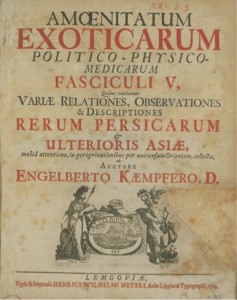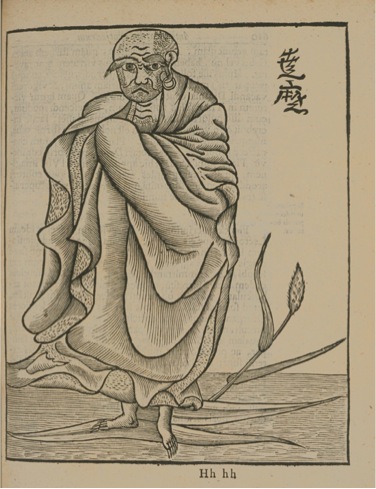Engelbert Kaempfer on Tea and Bodhidharma
The Japanese legend of the discovery of tea by the first Zen Patriarch Bodhidharma graphically detailed the dedication of the master to meditation. According to the story, Bodhidharma, known as Daruma in Japan, practiced a strict regimen of meditation at the Shaolin Temple outside the ancient Chinese capital of Luoyang by sitting in a nearby cave and facing the wall. He meditated in this fashion for many years until one day, without realizing his fatigue, he fell asleep. Angered by his inability to stay awake and concentrate, he ripped out his eyelids and flung them to the ground. Miraculously, the flesh sprouted into tea plants at his feet. Tasting the leaves, he felt refreshed and clear minded and immediately resumed meditation. His habit of tea was passed to his disciples and through them to the whole Buddhist community. Such was the origin of tea explained in Japanese folklore.
 The first ever literary expression of the Bodhidharma tea story appeared to have been written in Latin by the German naturalist and physician Engelbert Kaempfer (1651-1716 A.D.) while serving as surgeon to the Dutch East India Company. Between 1690 and 1692, Kaempfer was stationed at Deshima, the small island connected to the Japanese port of Nagasaki. A gifted botanist and keen observer, he wrote one of the most complete descriptions of tea of the time, noting not only the plant but also its Japanese name, cultivation, harvest, types of tea, preparation, preservation, use, virtues and vices, and implements and utensils for making and serving tea. In 1712, Kaempfer published his study of tea as “Theae Japonensis historia” in the third fascicle of Amoenitatum Exoticarum, otherwise known as Exotic Pleasures, and included the popular image of Bodhidharma depicted crossing the Yangzi River on a reed as well as the legend of the origin of tea.
The first ever literary expression of the Bodhidharma tea story appeared to have been written in Latin by the German naturalist and physician Engelbert Kaempfer (1651-1716 A.D.) while serving as surgeon to the Dutch East India Company. Between 1690 and 1692, Kaempfer was stationed at Deshima, the small island connected to the Japanese port of Nagasaki. A gifted botanist and keen observer, he wrote one of the most complete descriptions of tea of the time, noting not only the plant but also its Japanese name, cultivation, harvest, types of tea, preparation, preservation, use, virtues and vices, and implements and utensils for making and serving tea. In 1712, Kaempfer published his study of tea as “Theae Japonensis historia” in the third fascicle of Amoenitatum Exoticarum, otherwise known as Exotic Pleasures, and included the popular image of Bodhidharma depicted crossing the Yangzi River on a reed as well as the legend of the origin of tea.
“Tea, called Tsjaa by the Japanese and Theh by the Chinese, still has no character of its own accepted and approved by the universities. A character of its own is one that suggests the nature of a thing. Meanwhile, various substitutes have been used. Some characters at least indicate the sound of the word tea; others, the virtues and description of the plant. To the latter group belongs the character that represents the eyelids of Darma, a certain eminent holy man among the heathen. The story behind it is both charming and relevant, for it indicates the date of the first use of tea. With the reader’s permission, I will briefly pursue this digression.”
 “Darma, the third son of the Indian King Kosjuwo, was a holy and devout man, a kind of pope of the religious. He was the twenty-eighth successor to the Holy See of Sjaka, also a dark Indian, who was born 1,028 years before Christ and founded Oriental paganism. In A.D. 519 Darma journeyed to China. He devoted all his energy to fill the people with the knowledge of God and a true – as he called it – faith that would lead them to happiness. But in his endeavor to serve mankind not only with doctrine but also with good example, he strove to win divine grace by living in the open air and variously chastising his body and mastering his passions. He ate only vegetables. His idea of the highest state of holiness was to pass his nights sleepless and alert in constant satori, that is, in contemplation of the supreme divinity. To concentrate unceasingly upon God while denying the body rest and relaxation he considered the supreme achievement of a life of penance and the test of human perfection.”
“Darma, the third son of the Indian King Kosjuwo, was a holy and devout man, a kind of pope of the religious. He was the twenty-eighth successor to the Holy See of Sjaka, also a dark Indian, who was born 1,028 years before Christ and founded Oriental paganism. In A.D. 519 Darma journeyed to China. He devoted all his energy to fill the people with the knowledge of God and a true – as he called it – faith that would lead them to happiness. But in his endeavor to serve mankind not only with doctrine but also with good example, he strove to win divine grace by living in the open air and variously chastising his body and mastering his passions. He ate only vegetables. His idea of the highest state of holiness was to pass his nights sleepless and alert in constant satori, that is, in contemplation of the supreme divinity. To concentrate unceasingly upon God while denying the body rest and relaxation he considered the supreme achievement of a life of penance and the test of human perfection.”
“After vigils over several years, it happened that fatigued by long exposure and fasting, he succumbed to sleep. When he awoke, he cut off both his eyelids as the instrument of his sin and cast them in anger upon the ground in penance for his broken vow and as a precaution against the same thing happening in the future. Returning on the next day to the place of his punishment, he observed that by a wonderful transformation from each eyelid a shrub had grown – the tea plant. Either the plant had not previously existed or at the least mankind was ignorant of its virtue. As Darma ate the leaves (whether raw or prepared with water I do not know), he perceived a wondrous joy of spirit and strength to contemplate the divine. Because he commended this power hidden in tea leaves and the manner of eating them to his multitude of disciples, the use of this most noble plant readily grew and gained common approval as something about which no praise would be excessive. Meanwhile, the plant, as it lacked its own character, was conventionally represented by the eyelids of Darma. I am pleased to include here for the reader’s inspection a drawing of that famous man, the type that enjoys great veneration among the heathen. Beneath Darma’s feet is a reed on which, tradition relates, he traversed the sea and the rivers. So much for the name of tea.”
Source
Englebert Kaemper, Exotic Pleasures: Fascicle III Curious Scientific and Medical Observations, Robert W. Carrubba, trans. (Carbondale: Southern Illinois University Press, 1996), pp. 144-145. Cf. Engelbert Kaempfer (German, 1651-1716), “The Natural History of the Japanese Tea,” The History of Japan, John Gaspar Scheuchzer (Swiss, 1702-1729), trans. (Glasgow: J. MacLehose & Sons, 1906), vol. 3, pp. 218-221, fig. 139.
Figure
Engelberto Kaempfero (German, 1651-1716), Amoenitatum exoticarum politico-physico-medicarum fasciculi v, quibus continentur variae relationes, observationes & descriptiones rerum Persicarum & ulterioris Asiae, multâ attentione, in peregrinationibus per universum Orientum, collecta, ab auctore (Five fascicles of exotic pleasures regarding politics, physics, and medicine, which contain various relations, observations, and descriptions of Persian matters and regions beyond Asia collected through various expeditions through the entire Orient by the author) (Lemgoviae, Typis & impensis H.W. Meyeri, 1712), fasciculus III, observatio 13, p. 609, plate Hh hh.
